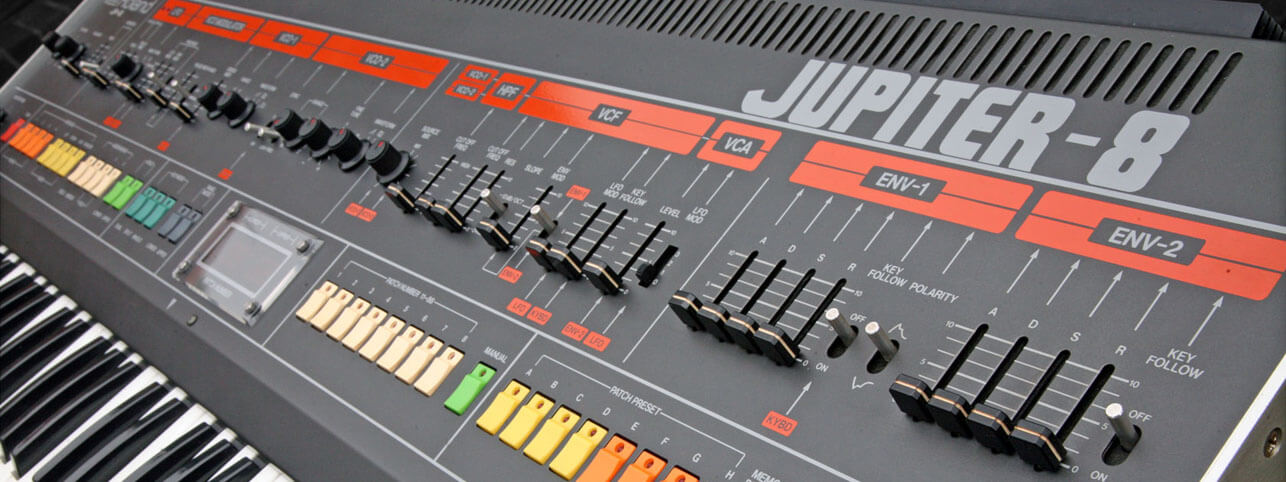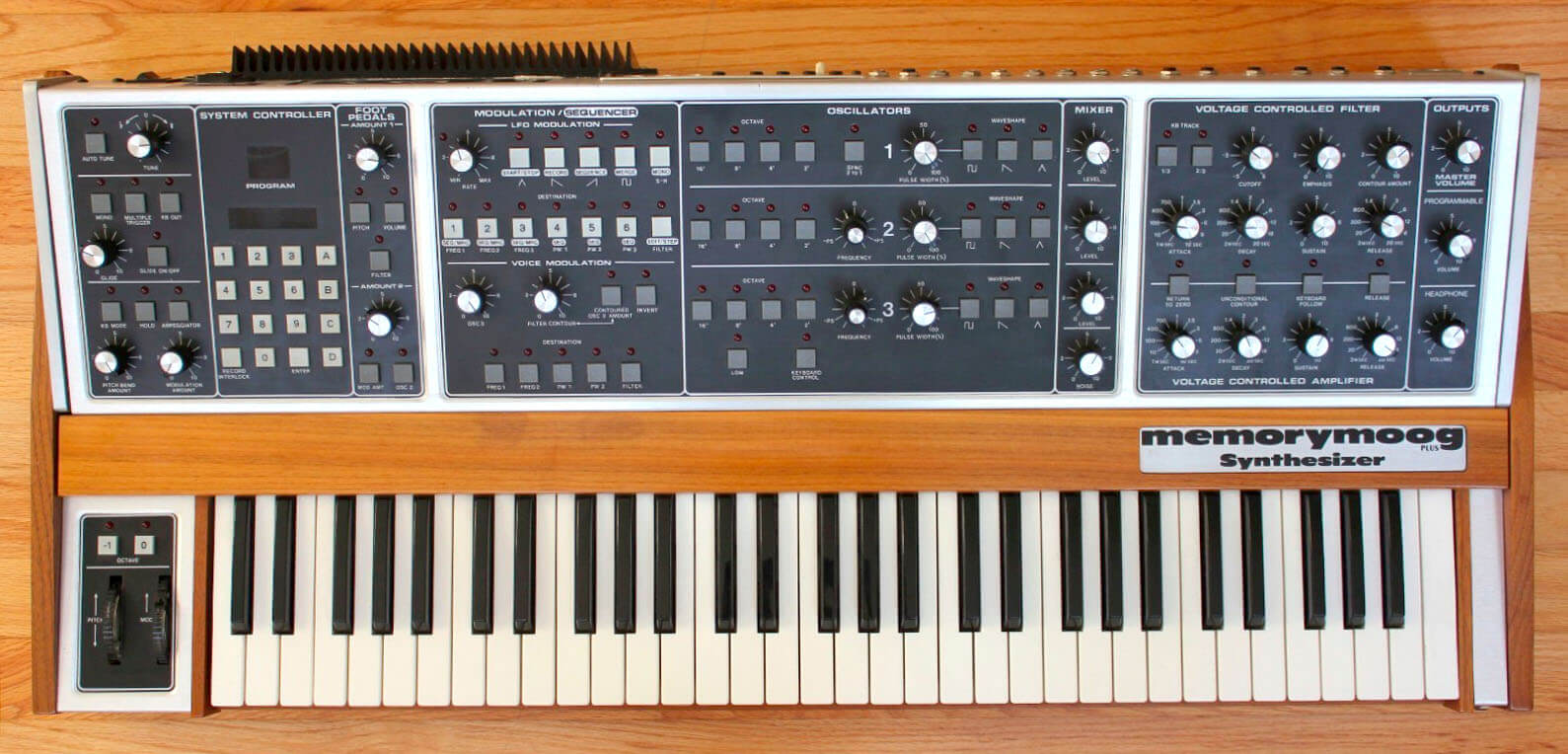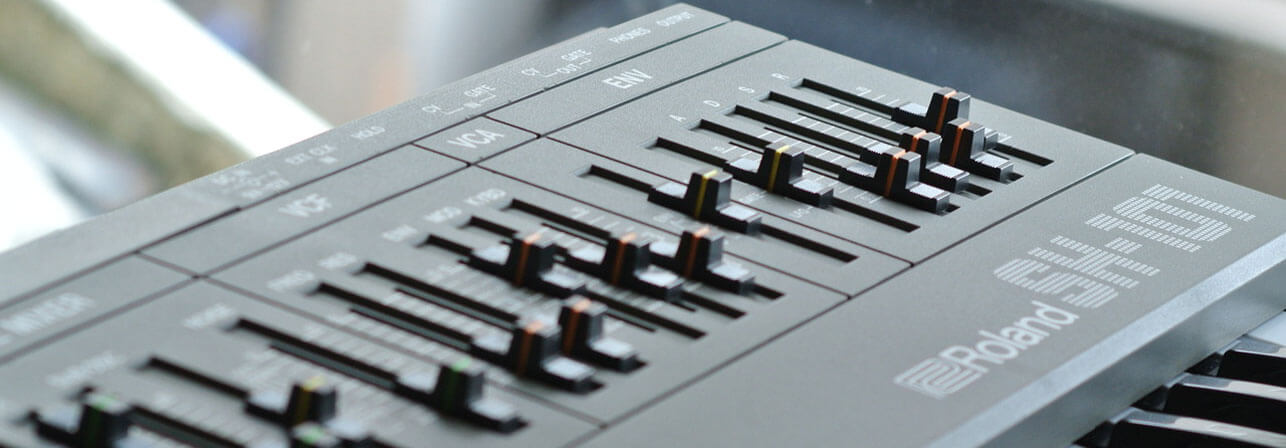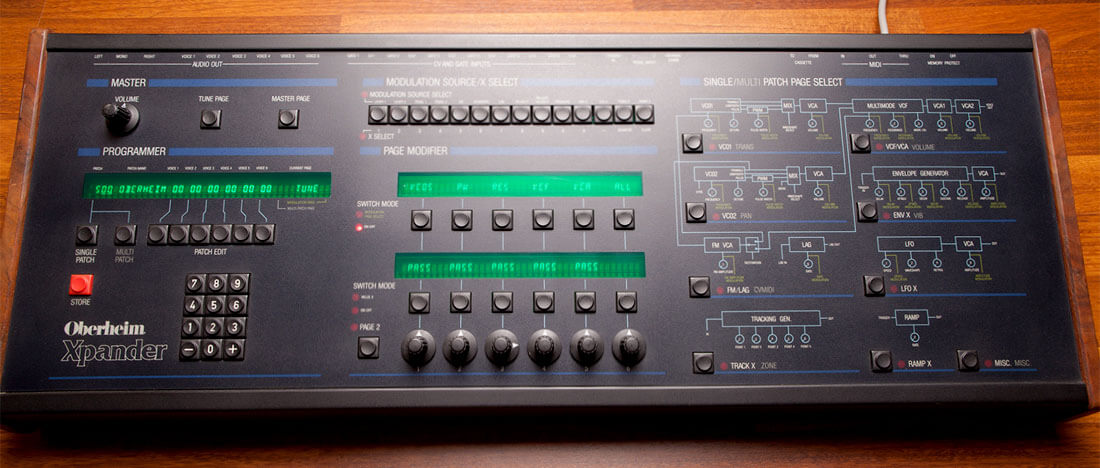9 Vintage Synths That Made History
Fat, Fuzzy, Beefy & Buzzy - it's the sound of Vintage Synthesizers. This week we're presenting 9 of our favourite vintage synths in chronological order. Which ones do you own, which would you like to own and which are your favourites?

1969 - EMS Putney VCS 3
Original Price: $430 + $195 (for keyboard)
Current Value: $12 000
From the querky sound effects of Dr Who all the way to Roger Waters, the EMS Putney VCS 3 is an all-time classic. Considered one of the first truly portable synthesizers, the VCS 3 was a masterpiece of engineering for its day [1969]. The electronics inside the unit were designed by Dave Cockerell alongside electronic composer Tristram Cary who was responsible for the aesthetics of the instrument.
Inside the VCS 3, EMS made us of 3-oscillators, a noise generator, 2 input amplifiers, a ring modulator, a 24dB/octave low pass filter, an envelope generator, a voltage-controlled spring reverb and 2 stereo output amplifiers. While most modular synths at the time used patch cords to link up the various components, a pin-based patch board matrix was used in the creation of the VCS 3.
Sonically, it made sense for the instrument to be used mainly for sound effects as there was no keyboard built in – however, a variety of external controllers were being made available soon after its release. The VCS 3 can be heard on Pink Floyd’s ‘On the Run’ and ‘Welcome to the Machine’ from ‘The Dark Side of the Moon’ album – more specifically on the latter, the unit was used to produce the pulsating bass part in the beginning of the song which formed the foundation for the entire production. The additional sound effects heard throughout the song also came from the same VCS 3.
1971 - ARP 2600
Original Price: $3 300 (in 1975)
Current Value: $7 950 (w/ 4012 ‘Moog’ Filter & No Keyboard)
Welcome to the world of semi-modular design – the predecessor of what would become the de-facto layout for the modern synthesizer. Where most instruments would require purchasing modules to be combined using patch cables, the ARP 2600 presented the user a set of basic components pre-wired internally, making it an ideal candidate for learning the art and craft of sound synthesis by newcomers.
Essentially a teaching instrument, the 2600 came packed with 3 oscillators, a 24 dB/octave filter, an ADSR envelope, a VCA [voltage-controlled amplifier] and a mixer section [for the 3 oscillators]. The unit also included an envelope follower, ring modulator, noise generator, an LFO complete with sample and hold, a spring reverberator and a pre-amplifier with stereo speakers.
An interesting is that all versions of the 2600 through 1976 used a copy of Moog’s patented ladder-filter which ultimately forced ARP to design a completely new filter, model 4072 which some consider to be sonically inferior to the previous 4012 filter based on Moog’s design.
In terms of sound, because ARP made its instrument with an inexperienced user in mind, the unit was adopted by a variety of artists ranging from Jean Michel Jarre to pop bands such as Depeche Mode. Daniel Miller, Depeche Mode’s producer mentions that the 2600 was used on every album the band has released up until Black Celebration in 1986.
The 2600 was also used to create the voice of the beloved R2-D2, in the hands of sound designer Ben Burtt. Andre Kelman of Oscilloscope Laboratories attempts an impersonation of the patch made famous by Burtt on his ARP 2600.
R2D2? Is that you? Oscilloscope Laboratories accidentally impersonates R2D2 on their ARP 2600 while running some samples for an upcoming gear feature in Attack Magazine.
1978 - Sequential Circuits Prophet 5
Original Price: $ 4495 (Rev 1 & 2); $ 3995 (Rev 3)
Current Value: $ 7500
Designed by Dave Smith and John Bowen, the Prophet-5 set out to become the first polyphonic analog synthesizer with patch memory. Produced in three revisions, approx. 6000 units were built – Rev. 1 is the least common and perhaps the most sought-after, as these 182 units were mainly hand-built by Smith and Bowen themselves.
From a technological standpoint, the Prophet 5 used five individual voices. Two VCOs [voltage-controlled oscillators] made up each voice with the possibility of mixing in a white noise generator going through a low-pass filter. The two oscillators are capable of generating sawtooth and square waves with variable pulse width, while the second can also produce a triangle wave. The unit also features individual ADSR envelopes controlling both the filter and the VCA, a single LFO [low frequency oscillator] and a pink noise generator which can be mixed to modulate all five voices.
The instrument was used by the likes of Benny Andersson (ABBA), Phil Collins, Depeche Mode, Eurythmics, Gary Numann, Radiohead, Pet Shop Boys amongst many, with a special mention for Rob Sabino who used the Prophet 5 to produce the iconic synth lines heard on ‘Like a Virgin’ by Madonna.
1981 - Roland Jupiter 8
Original Price: $ 5295
Current Value: $ 9300
Jupiter 8 was the first truly professional analog synthesizer released by Roland in 1981. Its world-class design and ease of use made it ideal for professionals in both live and studio setups. Used on countless records since its introduction, Jupiter’s fame is the result of clever engineering in its unique voice architecture which allowed for some of the biggest and fattest to be produced.
The synth uses 16 rich analog oscillators coupled in blocks of 2 per voice giving the unit a total of 8 voices of polyphony. Despite not being fitted with MIDI since it was released prior to the standardization of the protocol, instead it featured Roland’s proprietary DCB interface, which could later be converted into MIDI using various after-market kits. The Jupiter 8 also houses a variety of features including cross-modulation, oscillator syncing, an LFO and a classic arpeggiator. And while Roland isn’t perhaps the first choice when it comes to analog filters, the one included in the Jupiter 8 (and later in the Juno-6 / 60) was indeed an extra feature – 2-pole (12dB/oct) and 4-pole (24dB/oct) modes can be activated via the flick of a switch. In addition, there was also a separate high-pass filter built into the unit. Perhaps some of the most interesting features were the ability to split the keyboard into two zones, having a separate patch active on each zone and also its factory memory which could store up to 64 patches.
The iconic sound of the Jupiter 8 can be heard on records such as Michael Jackson’s Thriller, on the opening synth blasts. The patch was setup in a double four-voice mode, with the modulation wheel controlling the filter. Queen’s Radio Ga Ga also featured Jupiter 8’s arpeggiator used for creating the unmistakable bassline and also the solo on I Want to Break Free. Other notable mentions include ABBA, Marvin Gaye, Roxy Music, Duran Duran and Simple Minds to name only a few.
1981 – Korg Polysix
via Bob Augustin Geluidstechniek
Original Price: $ 1095
Current Value: $ 1999
Also released in 1981, Korg’s polyphonic synthesizer was one of the first reasonably-priced instrument (alongside Roland’s Juno 6) retailing at around $1000. The Polysix sounds classy, big and fat and was also one of the first poly synths to feature built-in effects – chorus, phaser and ensemble.
The warm-sounding pure analog sound was powered by a 6-voice engine with one VCO per voice, a sub-oscillator, a filter section with control over the envelope amount and keyboard tracking, a flexible ADSR envelope, an LFO which could be routed to the oscillator, filter or the amplifier, a clever arpeggiator for its time, capable of memorizing and sequencing chords across the keyboard and the classic chorus, phaser or ensemble effects unit. The effect section was a key feature which made the unit popular as it became a tool to fatten up the sound even more.
The Polysix has been used by the likes of Jean Michel Jarre, Keith Emerson, Damon Albarn (Blur / Gorillaz), Tears for Fears and Eric Prydz.
1982 – Moog Memorymoog Plus
via Sample Now
Original Price: $ 4795
Current Value: $ 9800
The year 1982 marks the last product launched by Moog, before the company was forced into bankruptcy in 1986. The company has since been revived after a long lasting legal battle which ended with Robert Moog reacquiring the rights and trademarks related to Moog Music in 2002.
The Memorymoog Plus featured basic MIDI, a sequencer, stable oscillators and, as the name suggests, it could store 100 patches in its internal memory. Some argue that the instrument was essentially a combination of six Minimoogs stacked into one super synth. This meant that apart from its 6-voice polyphony, the Memorymoog could also operate in unison, using a whopping 18 oscillators to produce the fattest and meanest sounding bass lines, for example. While it had no effects on board, it included a beautiful-sounding 24dB/octave low-pass filter fitted with ADSR envelope control per voice – an interesting feature indeed.
Worthy of its sound, the Memorymoog has been used by Jean-Michel Jarre, Bon Jovi, Nick Rhodes of Duran Duran and INXS, amongst many others who found uses for the rock-solid, thick-sounding beast of a synth which is the Memorymoog Plus.
1982 - Roland SH-101
Original Price: $ 495
Current Value: $ 1399
Roland introduced the SH-101 at a time when many of the professional synthesizers in circulation were out of reach for the average musician in terms of budget. The company marketed the 101 as an affordable option [a mere £249] for the ‘wannabe’ electronic musicians and new wave enthusiasts who thought they could conquer the world with a few synths and a bunch of songs. Consequently, some did actually reach worldwide recognition and fame – Depeche Mode was one such example.
Despite its low price point, the SH-101 sounded amazing – it was surprisingly rich for a single oscillator bolstered by a sub-oscillator. The single low-pass filter was one of the smoothest produced by the company to date and was considered one of the highlights of the unit. Clever design meant that the performer could also mix in varying amounts of different waveforms, including white noise, all dialed in via sliders. The sequencer was perhaps the most sought after technical feature, since it allowed the user to program in parts from the keyboard and to transpose the sequenced performance via octave buttons or the keyboard itself.
However, it is the SH-101’s design and visual appeal which made the unit truly popular. It was produced in red, grey or blue, it provided the option of purchasing a separate handgrip and shoulder strap and it could also be battery-powered. Roland built the 101 with the pop-star musician of the 80s in mind – a strategy which ultimately proved successful.
Throughout the years, the SH-101 has been used by Aphex Twin, The Chemical Brothers, The Prodigy, Union Jack and many more.
1983 - Yamaha DX7
Original Price: $ 1995
Current Value: $ 650
Arguably one of the most popular synths during the mid ‘80s, the Yamaha DX7 made the world stage since its debut in 1983. It was ground-breaking for its time, as it introduced a new type of synthesis called Frequency Modulation or FM. Despite being a fully digital instrument and somewhat hard to program by the analog-versed user, some patches sounded thicker than most analog synths. Yamaha has also included an excellent set of presets built into every DX7 before they were shipped out, many of which can be heard on countless top-charting records at that time.
The DX7 is one of the best-selling synthesizer of all time, not only due to its low price point but also because of its handful of features. The unit included MIDI – a brand new technology in 1983 – which was somewhat limited since the technology was implemented late in the production process; for example, the maximum MIDI velocity that the DX7 was able to transmit was around the 100 mark, as opposed to the maximum 127 defined by the protocol.
Its synthesis engine used 16 voices, each containing 6 sine wave oscillators which can modulate each other in a number of ways or, more precisely, 32 ‘algorithms’, as offered by Yamaha. The engine produces a variety of sounds that were much clearer and less linear than previous subtractive analog units. As is the case with most FM-based synthesizers, some of the more notable patches included electric pianos, bells and plucked sounds, generally with complex attack transients. For its time, the DX7 was a true marvel of engineering.
Another interesting trend emerged from the introduction of the DX7 revolved around patch design – since programming the unit was a tedious task and also because the unit featured inter-changeable patch-storing ROM cartridges, a market for custom presets was created and patch design for the DX7 soon became a lucrative business. After-market or factory sounds can be heard on numerous records since the ‘80s – the site Bobby Blues provides a list of some of the most famous songs which featured sounds from the DX7, complete with audio clips; also worth checking out is the Synthmania site which features all of the factory preset sounds built into the DX7.
1984 – Oberheim Xpander
Original Price: $
Current Value: $ 4000
The digital revolution in synthesizers had already begun by the mid ‘80s when Oberheim Electronics decided to bring to market the Xpander – a rack mounted version and the precursor to the legendary Matrix 12 released the following year in 1985.
The Xpander offered both subtractive and FM synthesis types, through 6 voices of polyphony with 2 oscillators per voice. But apart from its sound engine, its most ground-breaking feature was the inclusion of the matrix modulation system. For those of you familiar with Native Instrument’s Massive, the matrix built into the Xpander worked in a similar way, allowing for the connection of virtually any input and output the instrument has.
The Xpander is clearly not for the faint-hearted; it is intended to be used by the experienced synthesis who would sometimes struggle to figure out the thousands of possible combinations on the board. For example, one could have access to 15 individual LFOs and VCAs per voice – so you can imagine what this thing was capable of achieving in terms of routing. While there is not enough space to describe the complexity of its electronics and sonic possibilities I will attach a link to the manufacturer’s user manual but for all intent and purposes, the Xpander is one of those legendary analog classics which, to this day, produces some of the fattest, roundest, pleasantly analog synthesizers around – it is truly a synthesist’s dream come true.
In the hands of the skilled user it is a beast of a synthesizer – such users include Vince Clarke, Vangelis, Tangerine Dream, Human League, Depeche Mode, Chemical Brothers, Nine Inch Nails, MNDR and Hans Zimmer.








